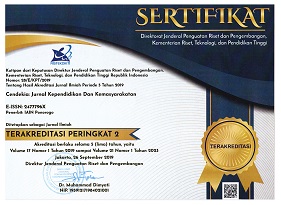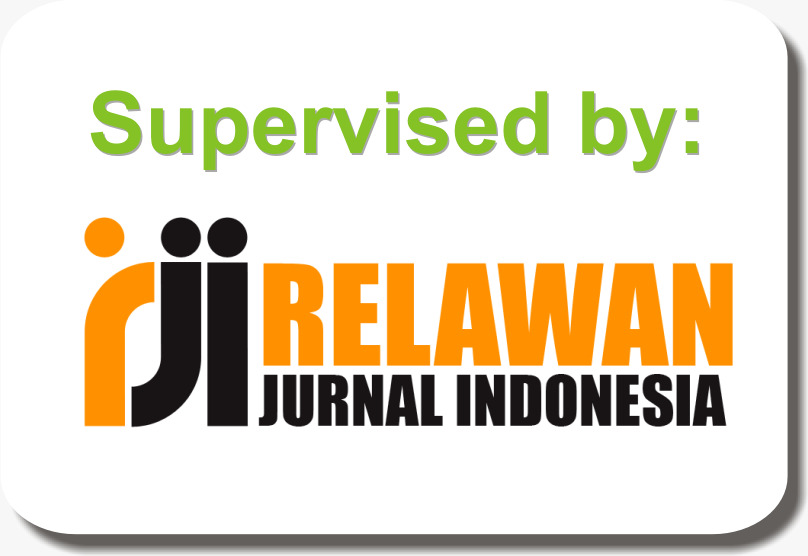تقويم تطبيق منهج 2013 ÙÙŠ تعليم اللغة العربية ÙÙŠ المدارس الابتدائية الإسلامية بÙونوروغو
DOI:
https://doi.org/10.21154/cendekia.v14i1.623Keywords:
Kurikulum 2013, bahasa Arab, metode.Abstract
Kurikulum adalah hal yang tidak terpisahkan dengan kegiatan pembelajaran. Ia senantiasa berkembang sesuai dengan perubahan dan tuntutan zaman. Seperti halnya di Indonesia, kurikulum yang digunakan sering kali berganti sejak awal kemerdekaan hingga saat ini menjadi kurikulum 2013. Pada kurikulum baru ini Bahasa Arab mendapatkan perhatian lebih, pasalnya sejak kelas 1 Madrasah Ibtidaiyah sudah diwajibkan belajar pelajaran ini. Itulah mengapa semua hal yang berkaitan dengan pembelajaran Bahasa Arab pada kurikulum 2013 ini menarik untuk diteliti, mengingat semua hal di dalamnnya adalah baru. Disinilah peneliti ingin mengungkapkan bagaimana implementasi pembelajaran Bahasa Arab untuk kelas 1 Madrasah Ibtidaiyah ini, mulai dari pengorganisasian materi, metode mengajar, dan tehnik evaluasinya. Obyek penelitian ini adalah Madrasah Ibtidaiyah yang ada di Kabupaten Ponorogo.Hasil dari penelitian ini adalah: (1) pengorganisasian materi bahasa Arab pada kurikulum 2013 menggunakan struktur logika dengan ciri yaitu berkesinambungan, berturut-turut dan saling melengkapi. (2) metode yang digunakan belum menggambarkan metode ilmiah, tetapi memadukan beberapa metode pengajaran. (3) tehnik evaluasi yang dilakukan oleh guru kelas satu di MI adalah tehnik evaluasi tugas dan tes lisan, tes tulis untuk mengukur pengetahuan. Sedang untuk menilai sikap guru menggunakan metode pengamatan. Dan untuk mengevaluasi keterampilan yang sering digunakan guru adalah proyek dan praktik serta portofolio
Curriculum is closely related with learning activities. The curriculum changes are designed to catch up with changing times. In Indonesia, the curriculum had undergone change since independence year (1945)to the latest curriculum 2013. The attention of this curriculum is paid more to the Arabic language because it must be taught at Madrasah Ibtidaiyah grade 1. Therefore, the implementation of Arabic learning for students of MI grade 1 in the curriculum 2013 is interesting to discuss. The researcher focuses on materials organization, learning method, and evaluation technique. The findings indicated that: (1) organization of learning materials of Arabic learning in the curriculum 2013 uses logical structures that works continuously, sequence, and complementary, (2) the methods has not used not a scientific method but combined with learning methods. (3) the teachers of MI grade 1 use some evaluation techniques, such as assignments, oral test, written test to assess their knowledge. Meanwhile to assess teacher attitude, observation is used and to assess the teacher skills are project and performance, portfolio as well
Downloads
Published
Issue
Section
License
Copyright & License
Please find the rights and licenses in Cendekia: Jurnal Kependidikan dan Kemasyarakatan. By submitting the article/manuscript, the author(s) agree with this policy. No specific document sign-off is required.
1. License
The non-commercial use of the article will be governed by the Creative Commons Attribution license as currently displayed on the Creative Commons Attribution-NonCommercial 4.0 International License.
2. Author(s)' Warranties
The author warrants that the article is original, written by the stated author(s), has not been published before, contains no unlawful statements, does not infringe the rights of others, is subject to copyright that is vested exclusively in the author and free of any third party rights, and that any necessary written permissions to quote from other sources have been obtained by the author(s).
3. User/Public Rights
The spirit of Cendekia: Jurnal Kependidikan dan Kemasyarakatan is to disseminate articles published as free as possible. Under the Creative Commons license, Cendekia: Jurnal Kependidikan dan Kemasyarakatan permits users to copy, distribute, display, and perform the work for non-commercial purposes. Users will also need to attribute authors and Cendekia: Jurnal Kependidikan dan Kemasyarakatan on distributing works in the journal and other media of publications. Unless otherwise stated, the authors are public entities as soon as their articles got published.
4. Rights of Authors
Authors retain all their rights to the published works, such as (but not limited to) the following rights;
- Copyright and other proprietary rights relating to the article, such as patent rights,
- The right to use the substance of the article in own future works, including lectures and books,
- The right to reproduce the article for own purposes,
- The right to self-archive the article,
- The right to enter into separate, additional contractual arrangements for the non-exclusive distribution of the article's published version (e.g., post it to an institutional repository or publish it in a book), with an acknowledgment of its initial publication in this journal (Cendekia: Jurnal Kependidikan dan Kemasyarakatan).
5. Co-Authorship
If the article was jointly prepared by more than one author, any author submitting the manuscript warrants that he/she has been authorized by all co-authors to be agreed on this copyright and license notice (agreement) on their behalf and agrees to inform his/her co-authors of the terms of this policy. Cendekia: Jurnal Kependidikan dan Kemasyarakatan will not be held liable for anything arising due to the author(s) internal dispute. Cendekia: Jurnal Kependidikan dan Kemasyarakatan will only communicate with the corresponding author.
6. Royalties
Being an open accessed journal and disseminating articles for free under the Creative Commons license term mentioned, the author(s) are aware that Cendekia: Jurnal Kependidikan dan Kemasyarakatan entitles the author(s) to no royalties or other fees.
7. Miscellaneous
Cendekia: Jurnal Kependidikan dan Kemasyarakatan will publish the article (or have it published) in the journal if the article's editorial process is completed. The editors of Cendekia: Jurnal Kependidikan dan Kemasyarakatan may modify the paper to a style of punctuation, spelling, capitalization, referencing, and usage that deems appropriate. The author acknowledges that the article may be published so that it will be publicly accessible, and such access will be free of charge for the readers, as mentioned in point 3.

















